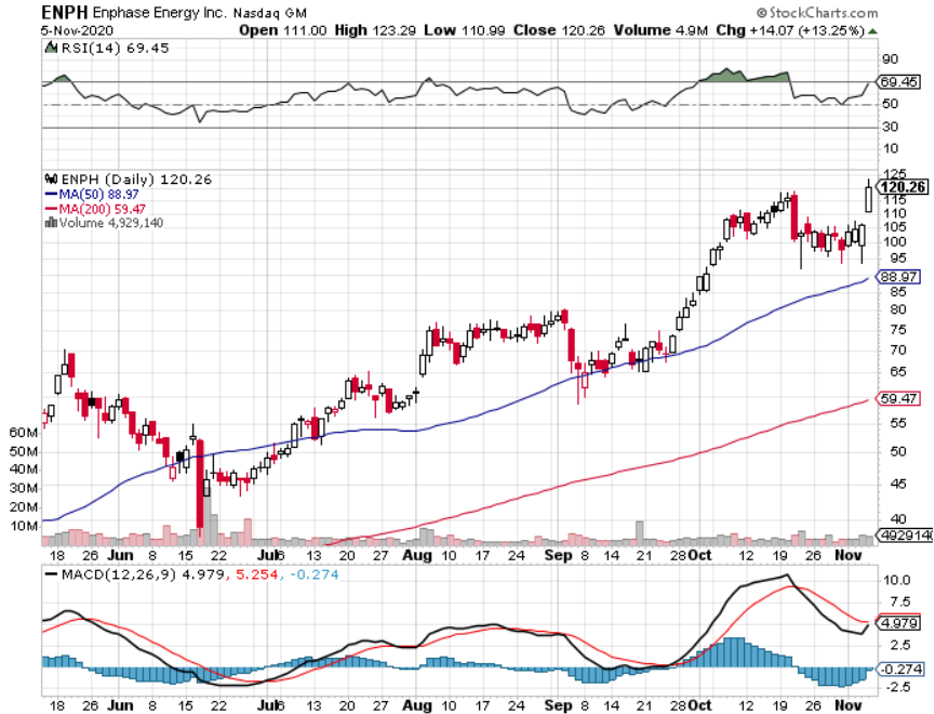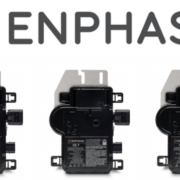Tech has been trending downwards for the past 2 months apart from this relief rally celebrating potential gridlock in the senate.
There is a high probability that tech will be dormant in the short-term offering me a great opening to focus on alternative industries adjacent to tech that is also forward-looking.
Despite the global pandemic destroying large segments of the U.S. economy, the solar sector has been a revelation.
This is not much of a surprise for long-time solar industry nerds since a similar decoupling occurred in 2009 when many economics were hard hit by the Financial Crisis of 2008.
Under normal seasonality, the solar industry typically strengthens each quarter with the first quarter being the weakest boding well for the last 2 months of 2020
Enphase Energy, Inc. (ENPH) is the company I would like to fill you in on today and they design, develop, manufacture, and sell home energy solutions for the solar photovoltaic industry in the United States.
Looking forward, Enphase expects third quarter revenues to range between $160 to $175 million.
One of Enphase's critical competitive advantages is that the company operates more as a technology company than a commodity manufacturer.
While other companies do produce its main power inverter product, Enphase has market dominance in the micro-inverter segment.
For residential solar applications, micro-inverters do offer an advantageous alternative. Enphase's shipment growth over the past couple of years is the empirical evidence.
Even more salient, the company avoids ruinous capital expenditures by deploying contract manufacturing similar to peers with proprietary technology.
By leveraging these variables, Enphase has accelerated its high gross margins above 30%.
The company's lower margins last year were in part due to higher expedited shipping costs to satisfy demand but has solved that bottleneck and boosted gross margins to over 40% this year.
Enphase's stable high gross margin is the x-factor.
Most solar module producers have high fixed costs which deteriorate margins and drag down utilization rates.
As a result, not only do shipment gyrate between industry cycles but also gross margin. While Enphase is also exposed to industry fiscal cliffs, high gross margins should be highly constructive even in down years.
During up cycles, Enphase's high gross margins and lower operating structure give it abnormally advantageous earnings leverage.
Enphase's earnings leverage will be even more dramatic once revenue growth reaccelerates after the pandemic filters through the U.S. economy.
Up until now, Enphase has been pigeonholed as an inverter company within the solar industry.
The company did offer a battery storage option, but it was not an overwhelming segment of total revenues.
This may change moving forward after the company's next generation Encharge storage option released lately has shown glimpses of stardom among its competition.
As the election grinds down to a bitter finish, Presidential candidate Biden has already announced a $2 trillion climate plan which obviously would include expanding solar installations and be on the table if Biden eventually claims victory.
While a Democratic blue wave could have opened up an opportunity for sweeping change for US solar companies such as Enphase, flipping the US Senate to Democratic control is not a prerequisite for the solar industry to be successful.
It’s already trending in that direction as a mega growth industry like technology.
Also, the Democrats will try to crowbar in any climate-related infrastructure spending with any potential stimulus bill which could add more dollars behind the solar industry.
If annual residential solar installations double with a slightly higher per home average, about one million homes would be converted to solar annually.
With over 139 million homes in the US, only a small fraction would be converted to produce solar electricity over the next decade or two, even if the US residential solar market doubled.
The main takeaway is that the solar market in the US still has a huge upside under the right policies.
Enphase has a current micro-inverter capacity of 10 million units annually and based on its per-unit assumption of 325 watts, can supply 3.25 GW annually.
Based on comments in the company's second quarter earnings conference call, capacity could potentially be raised to 16 million annually with the expansion of its Mexico-based facility and a new India-based contract manufacturer.
Given the lead time required to ramp, actual shipment capacity next year may only be equivalent to 4 GW. If the company's geographic mix remains steady with last year's 83.9% US exposure, about 3.36 GW would be allocated to the US market. This would represent about 68.6% of the total US residential and commercial market during 2019.
Should the US solar market double due to beneficial policies, Enphase's potential market share will rise above 34%.
This would represent about a 10% increase in US market share from Q4 2019.
Ultimately, Enphase's high margins and fixed cost structure should not be underestimated especially under a systemic industry shift such as a Biden-led US economy laser-focused on green infrastructure.
Enphase is one of a few cost-effective US solar companies with attractive products that could get a boost from favorable governmental policies.
Expanded US market share due to favorable policies could push annual earnings well above any expected scenario.
The secret recipe of high gross margin and low-cost structure make Enphase incredibly leveraged to top-line growth.
Lately, a new storage revenue stream and continued shipment growth in a rapidly expanding solar market should result in overperforming earnings growth.
New storage products will meaningfully add to earnings next year without diluting gross margin and Enphase's high US exposure could benefit under a Democratic administration more biased to renewable energy.
Enphase is an unequivocal buy and hold stock and it’s no surprise that shares are up 400% in 2020 at the time of the writing.





